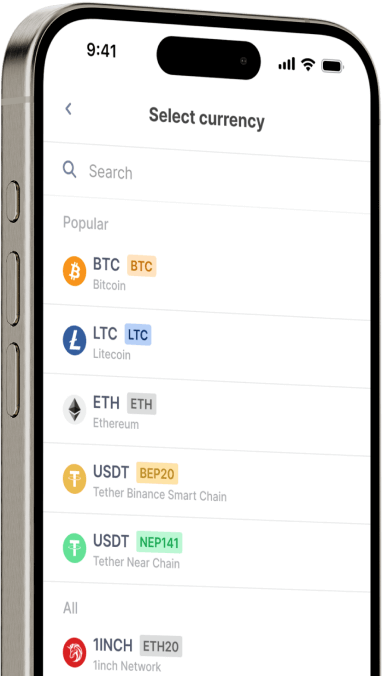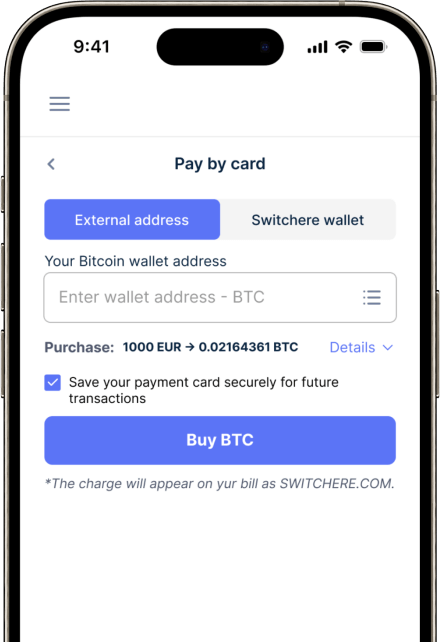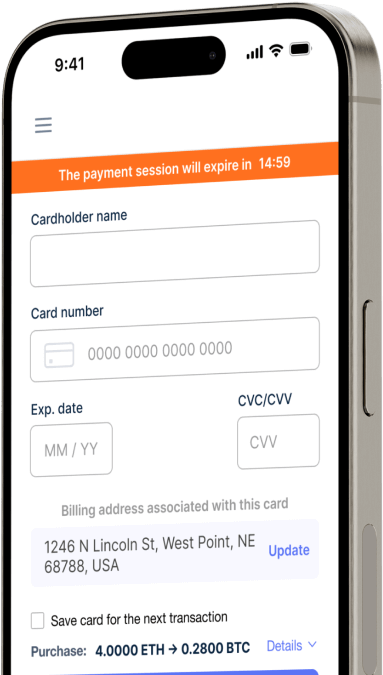Convert
Euro (EUR) to Litecoin (LTC) Instantly
Purchase Litecoin (LTC) with Euro (EUR) easily at Switchere and benefit from fast, secure transactions.
About
Litecoin (LTC)
Litecoin (LTC) stands as one of the earliest and most established cryptocurrencies, often referred to as the 'silver to Bitcoin's gold.' Launched in 2011 as a fork of the Bitcoin Core client, its primary purpose was to create a faster and lighter version of Bitcoin, suitable for everyday transactions. This digital asset operates on a decentralized network utilizing a Proof-of-Work (PoW) consensus mechanism, but distinguishes itself with the Scrypt hashing algorithm. This choice was initially aimed at allowing CPU and GPU miners to participate more effectively, though specialized Scrypt ASICs have since become dominant for mining this cryptographic security-focused coin.
Key distinguishing features of Litecoin include its faster block generation time, approximately 2.5 minutes compared to Bitcoin's 10 minutes, leading to quicker transaction confirmations. The LTC token serves as the native currency for paying transaction fees on its blockchain technology and is widely accepted as a medium of exchange and a store of value. Litecoin has historically been a pioneer in adopting new technologies, such as Segregated Witness (SegWit) which improves transaction throughput, and more recently, the MimbleWimble Extension Blocks (MWEB) upgrade, offering users opt-in privacy and enhanced fungibility for on-chain transactions. Its longevity and consistent development have solidified Litecoin's position as a significant and reliable peer-to-peer digital currency within the broader Web3 infrastructure and digital ledger ecosystem.
Buy Other 150+ Cryptocurrencies for Euro (EUR)
Other Coins for Euro (EUR)
-
EUR to ZRX
-
EUR to 1INCH
-
EUR to AAVE
-
EUR to ACH
-
EUR to ALGO
-
EUR to TLM
-
EUR to ANKR
-
EUR to APE
-
EUR to NFT
-
EUR to API3
-
EUR to APT
-
EUR to ARPA
-
EUR to AUDIO
-
EUR to AVAX
-
EUR to AVAX
-
EUR to AXS
-
EUR to BADGER
-
EUR to BAL
-
EUR to BNT
-
EUR to BAT
-
EUR to BNB
-
EUR to BSW
-
EUR to BSV
-
EUR to BLUR
-
EUR to BONE
-
EUR to CTSI
-
EUR to CELR
-
EUR to CELO
-
EUR to CEL
-
EUR to LINK
-
EUR to CHZ
-
EUR to CHR
-
EUR to C98
-
EUR to COMP
-
EUR to CFX
-
EUR to PEOPLE
-
EUR to CVX
-
EUR to ATOM
-
EUR to CTC
-
EUR to CRV
-
EUR to DAI
-
EUR to DASH
-
EUR to MANA
-
EUR to DENT
-
EUR to DGB
-
EUR to DYDX
-
EUR to XEC
-
EUR to EOS
-
EUR to ETC
-
EUR to ENS
-
EUR to ETHW
-
EUR to FET
-
EUR to FIL
-
EUR to FLOKI
-
EUR to GALA
-
EUR to GNO
-
EUR to ONE
-
EUR to HBAR
-
EUR to HOT
-
EUR to HOOK
-
EUR to ICX
-
EUR to ILV
-
EUR to IMX
-
EUR to INJ
-
EUR to ICP
-
EUR to IOST
-
EUR to IOTX
-
EUR to JASMY
-
EUR to JST
-
EUR to KAVA
-
EUR to KCS
-
EUR to KSM
-
EUR to KNC
-
EUR to LDO
-
EUR to LQTY
-
EUR to LPT
-
EUR to LOOKS
-
EUR to LRC
-
EUR to LUNA
-
EUR to MKR
-
EUR to MASK
-
EUR to EGLD
-
EUR to ALICE
-
EUR to NEAR
-
EUR to XEM
-
EUR to NEXO
-
EUR to NOT
-
EUR to NMR
-
EUR to OKB
-
EUR to OMG
-
EUR to ONT
-
EUR to EDU
-
EUR to OP
-
EUR to OGN
-
EUR to CAKE
-
EUR to PAXG
-
EUR to PENDLE
-
EUR to DOT
-
EUR to POL
-
EUR to QTUM
-
EUR to QNT
-
EUR to RDNT
-
EUR to XRD
-
EUR to RVN
-
EUR to REN
-
EUR to RSR
-
EUR to RLC
-
EUR to RPL
-
EUR to SFP
-
EUR to SHIB
-
EUR to SKL
-
EUR to SXP
-
EUR to STND
-
EUR to STG
-
EUR to XLM
-
EUR to GMT
-
EUR to STORJ
-
EUR to STMX
-
EUR to SUSHI
-
EUR to SNX
-
EUR to USDT (Polygon)
-
EUR to USDT (AVAC)
-
EUR to USDT (BEP20)
-
EUR to USDT (ERC20)
-
EUR to USDT (SPL)
-
EUR to USDT (NEP141)
-
EUR to USDT (FA2)
-
EUR to USDT (TRC20)
-
EUR to USDT (JETTON)
-
EUR to XTZ
-
EUR to GRT
-
EUR to SAND
-
EUR to TFUEL
-
EUR to THETA
-
EUR to RUNE
-
EUR to TON
-
EUR to TUSD (BEP20)
-
EUR to TUSD (TRC20)
-
EUR to TWT
-
EUR to UOS
-
EUR to UMA
-
EUR to UNI
-
EUR to USDC (Polygon)
-
EUR to USDC (SPL)
-
EUR to USDC (OP)
-
EUR to USDC (BEP20)
-
EUR to USDC (AVAC)
-
EUR to USDC (ARB)
-
EUR to USDC (ERC20)
-
EUR to VET
-
EUR to VRA
-
EUR to WAXP
-
EUR to WOO
-
EUR to WLD
-
EUR to WBTC
-
EUR to WMINIMA
-
EUR to XDC
-
EUR to YFI
-
EUR to YGG
-
EUR to ZIL
How to Buy Litecoin (LTC)
Frequently Asked Questions
-
What are the primary methods for converting Euros (EUR) to Litecoin (LTC)?
Converting EUR to LTC typically involves using a reputable cryptocurrency exchange that supports this fiat on-ramp. Users can deposit Euros via SEPA transfer, credit/debit card, or sometimes other Eurozone-specific payment methods. Once funds are credited, you can place an order for LTC on the EUR/LTC trading pair, facilitating a digital asset purchase directly.
-
What KYC/AML procedures are generally expected when purchasing Litecoin (LTC) with Euros (EUR) on a centralized exchange?
Most regulated cryptocurrency exchanges operating within the Eurozone require robust KYC/AML compliance for EUR to LTC transactions. This usually involves identity verification (passport, ID card), proof of address, and sometimes source of funds declaration to comply with European financial regulations before enabling fiat deposits and trading digital assets like Litecoin.
-
What technical aspects of Litecoin, such as its Scrypt algorithm or MimbleWimble (MWEB) integration, are relevant when considering EUR/LTC trades?
Litecoin's Scrypt mining algorithm contributes to its network security and distributed nature. The optional MimbleWimble Extension Blocks (MWEB) feature enhances privacy and scalability for LTC transactions, which can be a factor for users seeking improved confidentiality after acquiring Litecoin. Understanding these underlying technologies helps in appreciating Litecoin's utility beyond a simple EUR to LTC exchange.
-
Why might an investor choose the EUR/LTC pair for their cryptocurrency transactions?
The EUR/LTC pair offers direct access to Litecoin for Eurozone residents, often with good liquidity on major European crypto exchanges. Litecoin's faster block generation times compared to Bitcoin and its established history as a 'silver to Bitcoin's gold' make it appealing for quicker peer-to-peer electronic cash transactions. Trading directly from EUR avoids potential double conversion fees.
-
Are there notable differences in transaction fees or processing times when using EUR to buy Litecoin versus other fiat currencies?
When buying Litecoin with EUR, SEPA transfers are often cost-effective and relatively quick (1-2 business days), though instant options like credit/debit cards may incur higher fees. The Litecoin network's own transaction fees (paid in LTC) are typically low due to its Scrypt algorithm and efficient blockchain, regardless of the initial fiat currency used for the digital asset purchase.
-
How can I securely store Litecoin (LTC) obtained through a EUR/LTC transaction?
After acquiring LTC via a EUR/LTC fiat gateway, it's crucial to transfer your Litecoin from the exchange to a secure digital wallet where you control the private keys. Options include hardware wallets for maximum security, reputable software wallets, or the official Litecoin Core wallet. This practice mitigates risks associated with holding assets on a centralized trading platform and ensures true ownership of your peer-to-peer electronic cash.




